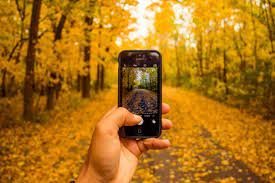Introduction: Apple’s “Shot on iPhone” campaign is a prime example of how a tech giant leveraged user-generated content and storytelling to showcase the capabilities of its product while creating a global marketing phenomenon. Launched in 2015, the campaign aimed to highlight the impressive camera quality of the iPhone by featuring stunning photographs taken by iPhone users from around the world.
Execution:
- Curated User-Generated Content: Apple sourced high-quality photographs captured by iPhone users through social media platforms like Instagram and Twitter. These images showcased a diverse range of subjects, landscapes, and artistic styles, demonstrating the versatility of the iPhone camera.
- Global Reach: The campaign featured photographs from various countries and cultures, emphasizing the universal appeal of the iPhone and its ability to capture moments from different perspectives. This global approach helped Apple connect with a wide audience and reinforce its brand presence worldwide.
- Integrated Marketing Channels: Apple utilized multiple marketing channels to promote the campaign, including social media, digital advertising, billboards, and television commercials. By employing a cohesive and integrated marketing strategy, Apple ensured maximum exposure for the “Shot on iPhone” campaign across different platforms and mediums.
- Engagement and Interaction: The campaign encouraged user participation by inviting iPhone users to share their own photographs with the hashtag #ShotoniPhone. This interactive element not only increased engagement but also empowered users to become brand ambassadors, further amplifying the campaign’s reach and impact.
- Creative Partnerships: Apple collaborated with influential photographers and artists to create additional content for the campaign. These partnerships helped enhance the campaign’s credibility and artistic appeal while attracting attention from photography enthusiasts and professionals.
Success Metrics:
- Social Media Engagement: The campaign generated millions of user-generated posts on social media platforms, with the hashtag #ShotoniPhone trending globally. According to Apple, the campaign received over 41,000 submissions from iPhone users within a few months of its launch.
- Brand Awareness and Perception: The “Shot on iPhone” campaign significantly boosted Apple’s brand awareness and perception, positioning the iPhone as a leading choice for photography enthusiasts and professionals. The campaign’s visually appealing content resonated with audiences and reinforced Apple’s reputation for innovation and quality.
- Sales and Revenue Impact: While Apple did not disclose specific sales figures directly attributable to the campaign, industry analysts and market research firms noted a positive correlation between the campaign’s success and iPhone sales during the campaign period. The campaign likely contributed to increased demand for iPhones, particularly among consumers interested in photography and visual content creation.
Key Factors Contributing to Success:
- Authenticity and User-Centric Approach: By showcasing photographs taken by real iPhone users, Apple created an authentic and relatable narrative that resonated with audiences worldwide. The campaign emphasized the capabilities of the iPhone from the perspective of its users, fostering a sense of community and connection.
- Visual Storytelling: The campaign’s visually stunning content captured the attention of audiences and effectively communicated the message of the iPhone’s camera quality without relying on traditional advertising tactics. The power of storytelling through imagery helped Apple evoke emotions and inspire creativity among consumers.
- Social Proof and Peer Influence: By featuring user-generated content prominently in its marketing materials, Apple leveraged the principle of social proof to instill confidence in potential buyers. Seeing real people produce impressive photographs with the iPhone encouraged others to perceive the device as capable and trustworthy.
- Community Engagement and Participation: The campaign’s emphasis on user participation fostered a sense of ownership and pride among iPhone users, turning them into active participants in the brand’s marketing efforts. By inviting users to share their own photographs, Apple created a sense of community and encouraged organic advocacy for the iPhone.
Lessons for Business Owners and Marketers:
- Empower Your Audience: Give your customers a platform to share their experiences and stories related to your product or service. User-generated content can be a powerful tool for building brand credibility and authenticity.
- Focus on Visual Content: Invest in visually compelling content that resonates with your target audience. High-quality images and videos can capture attention and convey your brand message more effectively than text alone.
- Create Meaningful Connections: Connect with your audience on an emotional level by telling authentic stories and showcasing real-life experiences. Building genuine relationships with your customers can foster loyalty and advocacy for your brand.
- Leverage Social Proof: Highlight testimonials, reviews, and user-generated content to demonstrate the value and credibility of your product or service. Social proof can help alleviate doubts and influence purchasing decisions.
- Consistency and Integration: Maintain consistency across your marketing channels and ensure that your messaging aligns with your brand identity. Integrated marketing campaigns that utilize multiple channels can maximize reach and impact.
Apple’s “Shot on iPhone” campaign exemplifies the power of user-generated content, visual storytelling, and community engagement in digital marketing. By harnessing the creativity and passion of its users, Apple successfully showcased the capabilities of its product while creating a global movement that resonated with millions of people. Businesses and marketers can learn valuable lessons from this campaign, including the importance of authenticity, visual content, and meaningful connections with customers.


